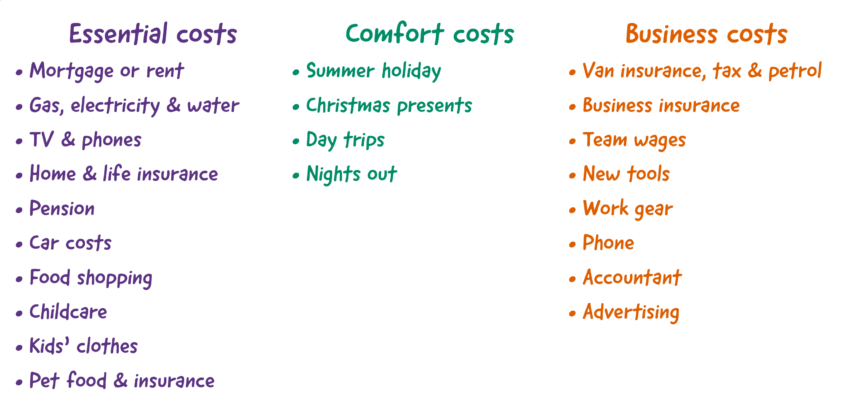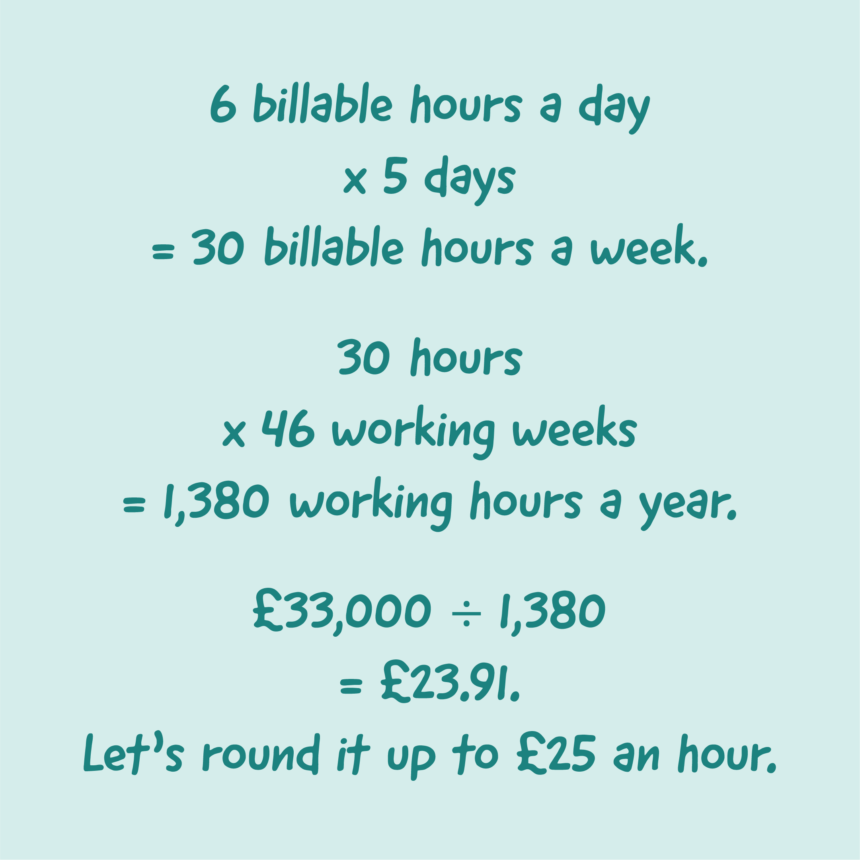


16 October 2020
For electricians, writing estimates and quotes comes with the territory. But knowing what to charge isn’t always easy. Looking after your cashflow and protecting your profits means having a clear idea how much you want to be paid for your time – but how do you work it out?
We’re here to help. If you’re wondering what electricians charge, how to calculate an electrician’s labour rate… or just why the whole thing feels so awkward, we’ve got you. We’ve put together a practical guide to working out your hourly rate, as well as a super-handy electrician’s rate calculator that’ll help you zero in on a figure, knowing you’ve got rock-solid reasons to back it up.
You’ve trained up, tooled up and built up your experience. You get there early, you work hard and you put in the hours – so you deserve to get paid properly for what you do.
The trouble is, nobody likes talking about what they earn, and everyone worries about what customers are prepared to pay… which makes settling on an hourly or daily rate for electrical jobs about as easy as finding your van keys in the dark.
It’s uncomfortable stuff. We get it. But it’s the only way to make sure you’re getting the cash you need to stay afloat, look after your business and do the things you love. So, we’re going to break it down, look at the costs you’ve got to cover and give you a practical, no-nonsense framework for setting your prices. Ready? Ok then…
Nobody likes talking about pricing. But nobody likes getting underpaid. Tweet thisThe best way to calculate your electrician’s labour rate, is to start with the big picture. How much do you want to earn per year? It’s another tough one to put your finger on, so let’s look at what other electricians are up to. What’s the average salary for a UK electrician?
Well, ask the internet how much electricians earn per year and you’ll quickly find there’s no simple answer. According to the Office for National Statistics, the average is around £33,000 a year, but that’s a median figure, which means 50% of sparkies earn more, and 50% earn less. The same goes for hourly rates too, ranging anywhere from £20 to £70 an hour.
Why such a big variation? Well, all kinds of things can push an electrician’s earnings up or down, including experience, type of work, whether you’re employed or self employed, and where you’re working. Electricians’ daily rates and annual salaries are inevitably higher in London and the South East, but then so is the cost of living, rent, running your business etc.
Electricians are consistently the highest earning trade, and wages are increasing year on year. Tweet this
With no easy way to compare yourself to the competition, how do you calculate your electrician’s labour rate? Well, the best place to begin is with what actually works for you. How much do you need to earn as an electrician to make sure your bills get paid, there’s food on the table, clothes on the kids and dinner in the dog?
Break those basic costs down, come up with a ballpark figure per month, times it by 12 and you’ve got a minimum amount you need to keep you and your family ticking for the year. Let’s call this your essential costs. The stuff you really can’t do without.
But life’s not just about getting by. You don’t graft all day just to make the bare minimum. So let’s factor in some of the stuff that makes it all worthwhile – a holiday, a few days out, a few pints with your mates, a curry on a Friday night. Work out what you’d like to be able to do, and a total cost per year. We’ll call this your comfort costs. The things that get you through the week.
Finally, think about the costs of running an electrical business. What does it cost to run your van for a year? To insure it, tax it and fill it up with petrol? How about insurance, phone bills, accountants, advertising, tools and work gear? Add all of those up and you’ve got a yearly figure for keeping your electrician business going. We’ll call this your business costs.


So, getting back to that annual salary, if you want to live comfortably (rather than on the edge of your seat), have the odd holiday and not be constantly worrying about making ends meet, you’re looking at: essential costs + comfort costs + business costs = minimum annual salary.
Of course, that’s just a baseline and you might well want to aim higher. Use your minimum annual salary as a starting point and set yourself a realistic target salary based on it.
Don’t forget, whatever salary you aim for, you’ll pay income tax out of it, which might affect your ability to meet those essential, comfort and business costs. To make sure you’re covered, check your tax rate and think about adding extra to your target figure to cover it.

Calculation 1:
essential costs + comfort costs + business costs = minimum annual salary.
Calculation 2:
minimum annual salary + ambition + tax
= target salary.
Once you’ve got your target salary, you can use it to calculate your electrician’s labour rate. Start by dividing your target salary by the number of days a year you want to work, minus holidays. According to Gov.uk, most employed people are entitled to 5.6 weeks’ holiday a year. As a self-employed person, you might want to match that, at least for starters.
On the other hand, you might want to go all-out for a couple of years and work even more – or take take things a little easier and work less. Decide what feels right for you – we’ll walk you through the maths so you can see if it’s workable, and you can play with the figures in our electrical rate calculator until you get the balance right.
So, target salary ÷ working days per year = your electrician daily rate. Divide that electrician daily rate by the number of hours you’d like to work per day and… Bingo! There’s your hourly rate too.
✏️ Pro tip:
Let YourTradebase do the maths. Scroll down to try our free electrician’s rate calculator.
Here’s how that might work in practice. Say for instance you wanted to aim for a target salary of £33,000, take 6 weeks’ holiday a year and work 8 hours a day, 5 days a week.
Realistically, you won’t always be able to charge for every hour of your working day – you’ll be travelling, picking up materials, pricing up jobs, all sorts of stuff that takes you away from your hands-on, billable work. So, let’s allow for 6 of those hours a day being billable, absorbing the cost of those non-earning hours. Here comes the maths…

Of course you can (and probably should) charge more than that. It’ll give you more of a safety net, keep you comfortable if things go quiet, and possibly even help you look more of a pro. But if you don’t know the minimum amount you can charge, you don’t know where to start, right?
If that feels like a lot of maths to get your head around, don’t worry, we’ve got you. Our quick electrician’s rate calculator does the tough stuff for you. Give it a go, play around with the numbers and get a clearer idea of what you can charge, how much you can work, and what you could be taking home at the end of the day.
Remember, the electrical rate calculator’s only going to do the maths based on what you tell it, so you still need to take a good look at the hourly rates it gives you to check whether they feel like reasonable, realistic figures you can quote to your customers.
Remember, you’ll have to pay income tax out of this figure, but if you’re registered for VAT or sales tax, you’ll be able to charge that on top.
✏️ Pro tip:
Save your labour rates in YourTradebase and we’ll add your quotes up for you.
Once you’ve got a clear idea of what you need to charge to cover your costs and hit your earnings targets, it’s easier to stick to it every time you quote. You’ll have a ready-to-go hourly or daily figure that helps you feel more confident and justified in your pricing – which means you can crack on and quote electrical jobs faster.
In YourTradebase you can even set an emergency call-out rate for late-night, weekend or bank holiday jobs, so you’re getting a fair price for giving up your free time.
✏️ Pro tip:
Everyone deserves a pay rise every now and then, so review your rates once a year to check they’ve got you covered.
One sure-fire way to earn more as an electrician – without working longer – is to increase the ratio of billable hours to working hours. You might be working hard all day, but if you’re spending too much time on paperwork, you’re missing out on the chance to get hands-on and earn more.
YourTradebase saves tradespeople an average of a day a week on paperwork – a whole day you could be rolling up your sleeves and bringing in extra cash. It’s a made-for-trades toolkit full of quick, easy ways to blast through electrical estimates, quotes, invoices and more, sending out smarter stuff sooner, and winning more work, week in, week out.
No fuss. No strings. No credit card needed.